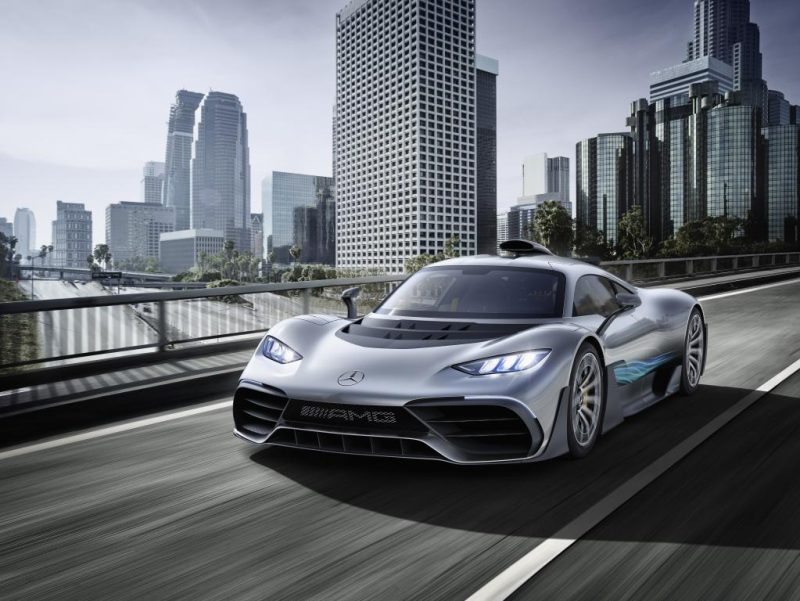The two-seater supersports car brings the very latest and efficient, fully-fledged Formula 1 hybrid technology from the race track to the road almost par for par to represent the highlight of AMG’s 50th anniversary. This high-performance hybrid is said to produce over 1.000 hp and reach top speeds beyond 350 km/h. The show car combines outstanding race track performance and day-to-day suitable Formula 1 hybrid technology with exemplary efficiency. This is a world first.
The overall responsibility for the realisation of Project ONE lies with Mercedes-AMG. The complex development work was carried out in close cooperation with the Formula 1 experts at Mercedes-AMG High Performance Powertrains in Brixworth and with the Mercedes-AMG Petronas Motorsport team in Brackley.
The Mercedes-AMG Project ONE provides another insight into the future performance-hybrid drive strategy of the sports car brand within Mercedes-Benz.

Powertrain: one turbocharged engine and four electric motors
The high-performance plug-in hybrid drive system of the Mercedes-AMG Project ONE comes directly from Formula 1, and was realised in close cooperation with the motorsport experts of Mercedes-AMG High Performance Powertrains in Brixworth. It consists of a highly integrated and intelligently networked unit comprising one hybrid, turbocharged combustion engine with a total of four electric motors. One has been integrated into the turbocharger, another has been installed directly on the combustion engine with a link to the crankcase and the two remaining motors drive the front wheels.

The 1.6-litre V6 hybrid petrol engine with direct injection and electrically assisted single turbocharging comes directly from the Mercedes-AMG Petronas Formula 1 racing car. The four overhead camshafts are driven by spur gears. To achieve high engine speeds, the mechanical valve springs have been replaced by pneumatic valve springs. The vehicle is mid-engined (ahead of the rear axle) and it can easily reach speeds of 11,000 rpm, which is currently unique for a roadgoing vehicle. However, for higher longevity and the use of commercially available Super Pluspetrol instead of racing fuel, it remains significantly below the F1 engine speed limit.
The electric motors on the front axle are also true rev wonders, with rotor revolutions up to 50,000 rpm – current state of the art is a speed of 20,000 rpm.
The very high-revving engine is additionally boosted by a high-tech turbocharger. The exhaust gas and compressor turbines are separated from one another and located at an optimum position to the exhaust side and to the intake side of the V6 engine, and connected to one another by a shaft. This shaft features an electric motor with approximately 90 kW which, depending on the operating status, electrically drives the compressor turbine with up to 100,000 rpm – for instance when moving off or following load changes. The Formula 1 designation for this unit is MGU-H (Motor Generator Unit Heat).

Lightning-quick response, faster than a naturally aspirated V8 engine
The major advantage: the dreaded turbo lag – the delayed response to accelerator pedal commands owing to the inertia of the large charger – is completely eliminated. The response time is greatly reduced, and is even shorter than that of a naturally aspirated V8 engine. The electric turbocharger brings about another advantage: it uses parts of the surplus energy from the exhaust system to generate electricity, and either stores it in the high-voltage lithium-ion battery as part of recuperation or provides additional drive power by feeding it to an additional electric motor. This motor produces 120 kW, has been installed directly on the engine and features a link to the crankshaft via a spur gear (MGU-K = Motor Generator Unit Kinetic) – another technology that ensures maximum efficiency and performance in Formula 1.
New all-wheel drive with purely electrically driven front axle
There will also be two further 120 kW electric motors at the front axle. Each is connected to a front wheel via a reduction gear. The fully electrically driven front axle allows individual acceleration and braking of each front wheel, and therefore selective torque distribution (torque vectoring) for particularly high levels of vehicle dynamics. With the axle motors, we estimate that up to 80 percent of the braking energy can alsobe optimally used for recuperation under everyday driving conditions. This energy is stored in the battery and is available for a longer electric range. Each electric motor is controlled by its own power electronics located in close proximity to the electric motors in the floor assembly.
Lithium-ion battery with Formula 1 technology
The battery cells, their arrangement and the cell cooling system are the same as used in the Mercedes-AMG Petronas Formula 1 racing car. However, the quantity of battery cells in the AMG Project ONE will make it significantly more practical for everyday use. The lithium-ion, high-voltage battery and the DC/DC converter supporting and charging the 12 Vonboard electrical system are space-savingly accommodated in the vehicle floor behind the front axle.
As a further innovation, the high-voltage EQ Power+ drive system operates with 800 volts instead of the usual 400 volts. Thanks to the higher voltage levels it is possible to influence elements, such as significantly reducing the cable diameters and accordingly saving design space and weight.
Intelligent operating strategies for optimum output and efficiency
Overall the high-performance EQ Power+ plug-in hybrid drive system offers numerous intelligent operating strategies which are optimally tuned to different application scenarios. The driving modes range from purely electric operation through to a highly dynamic mode which corresponds to a setting used in Formula 1 qualifying for optimum lap times. Despite the high system complexity, and depending on the current requirement, the driver will always receive the optimum combination of performance and efficiency. In this process, Mercedes-AMG engineers make use of the many years of experience and know-how from Formula 1, the SLS AMG Electric Drive and Daimler AG’s research and development.

For instance, the driver can move off purely electrically, initially with just the electric motors on the front axle driving the hypercar and the electric motor on the crankshaft supporting short-term acceleration wishes. If the driver presses the accelerator more firmly and demands more output, the V6 engine also switches on. The drive system unfolds its full power as the engine speed increases. Impressive acceleration figures are possible with the Race Start function: acceleration from zero to 200 km/h takes under six seconds.
If the driver’s foot leaves the accelerator again to let the car coast, the system switches to electric drive at the front axle – whilst braking under normal driving conditions recuperates up to 80 percent of the energy, which is fed into the battery.
Completely new, automated 8-speed manual transmission
Power is transferred to the rear wheels by an 8-speed manual transmission that has been entirely developed from scratch for theMercedes-AMG Project ONE. It is activated hydraulically and can be operated in automated mode or manually using the shift paddles.
The basis for the outstanding driving characteristics of the Mercedes-AMG Project ONE is provided by the lightweight, high-strength carbon-fibre monocoque body, the technology of which likewise comes from Formula 1. The same applies to integration of the engine and transmission: both have load-bearing functions and completely support the rear suspension.

Exterior design: Beauty and the beast
The design of the show car is very obviously inspired by the premium class in motorsport. But above all, it embodies the Mercedes-AMG principle that fascination is always linked with function. Every part has a specific purpose. The result is a mid-engine concept, extremely muscular proportions with the cockpit well forward, large wheel arches, a wasp waist and an extended rear end.
Interior: Formula 1 for two
The interior design concept follows function on the racetrack, and this is expressed in the radical design idiom. Formula 1 technology is made authentically tangible on both the race track and the road. Here too every detail has a function, with nothing included merely for visual reasons. In the monocoque interior, the reduced components are emphasised in minimalist style both in design and functional terms.
The ergonomically contoured interior has room for two occupants. The bucket seats with adjustable backrests are integrated into the monocoque. The pedals and steering wheel are adjustable, allowing the driver to adopt the ideal driving position. The centre tunnel visually separates the driver and passenger areas from each other. It blends fully into the seat sculpture and follows the principle of minimalism with its gently rising contour.
The Mercedes-AMG Project ONE will not only bring current Formula 1 hybrid technology onto the road and combines top-class race track performance with full day-to-day suitability. Its purpose is also to obtain extensive findings about performance-oriented plug-in hybrid drive technology, further developments of suspension layouts and extended onboard electronics that will later benefit series production AMG cars. The Project ONE team is working hard on successfully bringing this vision onto the road.












